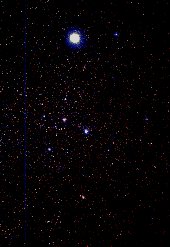
The Messianic Star Identified
Sirius, commonly known as the Dog Star, or simply ‘The Dog’ to the Greeks and Romans, is the brightest star in our sky. It tends to sit fairly low in the sky, and sometimes scintillates with the colours of the rainbow, due to atmospheric effects experienced visually while viewing near the horizon. We have already seen how it is strongly associated with ancient female deities, particularly the Egyptian goddess Isis. What may be surprising to many is that a certain astronomical aspect of Sirius is steeped in controversy, and has been for centuries; namely, its colour!

Sirius
is a bright, white star. Yet there are many references in ancient
literature to its redness. Astronomers have been attempting to come
up with an explanation for this, so-called ‘red’ Sirius anomaly, for hundreds
of years. Dependent largely upon the cosmological theories in favour
during various times, the preferred solution to this problem has banded
back-and-forth. On the one hand, it is held that Sirius could never
have been red, and that the quotes from the ancient literature were simply
erroneous, and on the other hand it is held that this anomaly describes
an intrinsic change in Sirius’ character as a star, that requires explanation.
Unfortunately, there is none. Sirius simply could not have changed
colour in this short time, least of all from red to white. A complete
solution to this puzzle remains elusive, although much of the erroneous
material clogging up the debate has been adequately dealt with.
I am in the unusual
position of being able to offer a new, and radical, explanation, with potentially
far-reaching consequences. Given the generally poor level of debate
regarding this anomaly historically, however, it must be noted that my
explanation is a working hypothesis only. I do not wish to pin the
strong case for the Dark Star Nibiru onto this poorly documented anomaly
without this proviso. Even so, it will become evident that it might
offer us a dramatic opportunity to establish Nibiru’s passage during Christ's
life-time.
Professor Whittet of the Rensselaer Polytechnic Institute introduces his 1999 paper, "A Physical Interpretation of the ‘red Sirius’ Anomaly", with this summation:
"Sirius A, the brightest star in the night-time sky, appears white to the unaided eye, consistent with its classification as an A1 V star with negligible interstellar reddening. Historical evidence that Sirius appeared red as recently as 2000 years ago has been widely discussed in the literature in recent years. This phenomenon, which I refer to as the ‘red Sirius’ anomaly, appears to have stimulated interest and scepticism in almost equal measure. The evidence is based on interpretations of ancient texts from several cultures, including Babylonian, Greco-Roman, Chinese and early mediaeval European sources, over a time span of approximately 1400 years.
"Some of the claims have been disputed on grounds of misidentification or misinterpretation: as an example of the former, the star supposed to be Sirius in the early mediaeval Lombardic text discussed by Schlosser and Bergmann (1985) may be identified more reasonably as Arcturus. Ancient Chinese texts have been re-evaluated in detail by Jiang (1993), who concludes that all such reliable sources are consistent with Sirius being white. However, other historical evidence for a red Sirius seems both reliable and unambiguous. Babylonian cuneiform texts, and the writings of classical Greco-Roman authors, including Cicero, Horace, Seneca and Ptolemy, refer consistently to Sirius as a red or reddish star. Seneca (c.25AD) stated the redness of Sirius to be ‘deeper than that of Mars’." (1)
Whittet then analyses some of the proposed ways in which a star could change colour temporarily and concludes that none of these fit the data about Sirius given our present understanding of astrophysics. So he then attempts to discover an extrinsic cause, more due to the viewing conditions that the observers were subject to, and concludes that the reddening of the star observed was due to observers witnessing Sirius during its heliacal rising and setting (1,2). He also shows that the later recordings of ‘red Sirius’, particularly that of Ptolemy in 150AD, were down to plagiarism of traditional texts by other authors adding to his text:
"Why did Ptolemy, an experienced observer, list Sirius amongst red stars without qualification? The answer will probably never be known, but Ceragioli (1996) (4) suggests two possible explanations. First, as an astrologer, Ptolemy may have been more concerned with the astrological significance of Sirius than with its usual physical appearance. Secondly, it has been shown that parts of the Almagest were probably not attributable to Ptolemy himself - tradition seems to have played an important role in shaping the text, and a tradition that emphasized ‘red Sirius’ may have been favoured over objective observation." (1)
The importance of Ptolemy’s astronomical catalogue, the Almagest, cannot be under-estimated, and for that reason the reference within it to Sirius’ redness became the most important piece of evidence for the argument that Sirius was once red. But as important as the text is, it was subject to much editing in the centuries after Ptolemy wrote it, and certain erroneous interpolations have been noted. It seems likely that this is the reason for the reference to a ‘red Sirius’ in the Almagest, especially as Ptolemy himself made no reference to this anomalous colour in the star catalogue in his accompanying astrological text, the Tetrabiblos. (4)
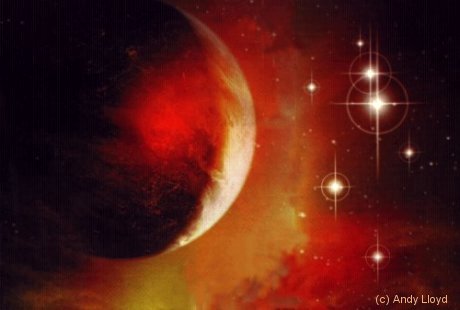
So most of the evidence about Sirius being red can be dismissed, except that of Seneca in 25 AD. Ceragioli has produced excellent papers on the historical evidence for the redness of Sirius (3,4), and concludes that Seneca offers the most unassailable and credible description to support its veracity.
Accounts before Seneca seem a to have been composed
in a rather more poetic fashion, particularly that of Cicero’s translation
of Aratus, and were largely taken out of context. As noted above,
later Greek accounts seem to rely heavily on a tradition of ‘red Sirius’
derived from Seneca. But the 1st century Roman’s description is more
difficult to explain away, as Ceragioli describes:
"Much more straightforward is the Roman philosopher Seneca (early to mid first century A.D.)… In his prose treatise on nature, the Naturales Quaestiones, Seneca discusses the causes of fiery phenomena in the sky such as lightning and meteors; he mentions Aristotle’s opinion (Meteorologica 1.4.341b) that the Earth exhales different varieties of particles into the air, some of which catch fire. Seneca then remarks:
"Nor is it strange if the Earth’s exhalation is of every sort and diverse, when in the sky too the colour of objects is not uniform, but rather the red of the Dog Star is piercing, while that of Mars is mild, and Jupiter has none, its glow being translated into clear light." Seneca, Naturales Quaestiones 1.1.7
"This passage has always been recognised as the most compelling evidence beyond Ptolemy’s (which Ceragioli later shows is possibly derived from Seneca). It is straightforward and unambiguous. Yet even so it has often been misunderstood. Usually the key words are summarised as saying that "Sirius is redder than Mars". But the is not what Seneca means. He says that "the red of the Dog Star is piercing (acrior), while that of Mars is mild (remissior)", meaning that Sirius’s redness is somehow vivid and striking, while Mars is flat and nondescript. It is a question of greater vividness, not a deeper shade of red." (3)
A few things should be noted about all of this. Other accounts roughly contemporary with Seneca describe Sirius as white, as we see today. Yet, during his discussion of fiery phenomenon in the sky, he chooses to describe Sirius’ piercing redness, described in the present tense. This tends to suggest a short-lived phenomena, picked up by only a few astronomers of that time. But also a very real one. The piercing vividness of the star denotes its unusual visual impact.
The 'Red' Nibiru Anomaly?
Let us assume that the Dark Star Theory is right, and that a brown dwarf star appeared in the sky near Sirius during the time of Christ. Would it not appear as a piercing red star? Is it possible that the brown dwarf’s brightness and fiery countenance effectively eclipsed the dominance of Sirius in that portion of the sky, causing observers at that time to conclude that Sirius was red? That Seneca misinterpreted its anomalous appearance as Sirius, setting in motion an erroneous tradition of ‘red Sirius’, that has perplexed astronomers ever since.
Whilst writing about fiery celestial phenomena in 25 AD, he rather bizarrely included Sirius, which he perceived at that point in time as red. Perhaps its unusual countenance was actually the reason he wrote this essay in the first place, in an attempt to explain why Sirius was now red. But instead, unknown to him, he was looking at the altogether brighter Nibiru in Canis Major!

This is a remarkable proposition, one which might seem a little far-fetched when examined out of context. Yet the Dark Star Theory already calls for the appearance of a bright red star near Sirius during the time of Christ, and here it is. In 25 AD.
The account is accepted by astronomical researchers to be honest and accurate, the problem for them simply being what it could mean. The modern scientific explanation centres around the ancient tradition of viewing Sirius as it sat on the horizon, explaining its apparent redness extrinsically.
Yet this ‘solution’ is problematic, as Sirius would still have been a bright, white star under normal viewing conditions, and therefore should have been described as such. The ancients may have had some unusual ideas, but they were not fools. Ceragioli cites the German astronomer H. Osthoff as producing the strongest rebuttal to this scintillation and absorption theory, a theory that now holds sway among astronomers:
"He (Osthoff) criticised the hypothesis of scintillation and absorption - no doubt thinking about Ptolemy - by saying: "But does an experienced observer let himself be deceived by this? At higher altitudes coloured scintillations diminish and the true colour of the star can be easily recognised. Likewise it is questionable whether one may adduce as an explanation the redness of the star at rising and setting which results from the unfavourable air of the lowest strata. Why is this false colour not cited in the case of all other white stars?" These are important questions which are still in need of an answer today." (3)
Quite. A tradition of Sirius appearing red formed from Seneca’s account, despite other contemporary accounts identifying it correctly as white, including many Roman texts that described it as ‘sea-blue’. The strength of that tradition among 1st and 2nd Century astronomers, like Ptolemy, points to the impact of the ‘red star’s’ description by Seneca, a significance certainly not lost on the Egyptians. It may also have triggered the resurgence of the cult of Mithras in the Roman Empire.
My contention is that Seneca’s ‘red Sirius’ reference marks an historic appearance of the red Nibiru near Sirius, a sighting profound enough in the Greco-Roman world that it remained part of their astronomical tradition for more than a century afterwards. But in the Middle East, this astronomical event was seen as something far more significant still, and marked a sea-change in world history, as Nibiruan appearances tend to do. The Mesopotamian and Egyptian traditions which had managed to maintain the belief in the Winged Disc had been anxiously awaiting its reappearance since the time of Alexander the Great. It was late, and had overshot its average 3,600 year passage by about 5 generations. The Messianic Star, Horus, was overdue, and rumours of the appearance of the Messiah were raging in the occupied lands of Israel and Egypt. They would surely not have made the same mistake as Seneca. Carefully they watched the heliacal setting and rising of Sirius for a sign of the return of the Winged Disc. Can it be that their vigilance was rewarded in 25 AD?
Yet the anomalous appearance of the ‘Star of Bethlehem’ is traditionally understood to have occurred at the start of Jesus’ life, not near its end. What is going on here? All will become apparent, but first I would like to address another problem. If Nibiru appeared as a bright red star near Sirius, then why didn't Seneca describe its bizarre retrograde motion across the heavens, a movement that would clearly contra-indicate its identification as Sirius?
Nibiru’s Conjunction With Ra
Whittet and Ceragioli’s argument that the viewing of this assumed ‘Sirius’ occurred near the horizon may give us a clue as to why the Star, if it was Nibiru, was not described as a planet journeying through the heavens. Simply put, the sighting may have occurred at the crucial point of the disappearance of Sirius from the skies, during late Spring, denoting its perihelion passage to be on the other side of the Sun (this may neatly explain old North American mythology describing the gods as living on a 'planet behind the Sun'; but more on this another time).
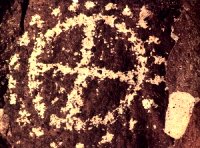
In the same way that planets cannot be observed when in conjunction with the Sun, so too could Nibiru disappear during its brightest point of the perihelion passage. The ability for the ancients to have followed Nibiru’s movement across the heavens was, therefore, very much dependent upon the time of year it appeared.
Consider this argument: Many people who have read the Dark Star Theory to date have pointed out the apparent problem of Nibiru’s extreme distance from the Sun at aphelion. 25,000 Astronomical Units is a tremendous distance, it must be said, and an elliptical orbit attaining this length of longitudinal axis is conventionally ascribed as several million years. Yet the new discoveries of the orbits of extra-solar planets indicate that this need not be so. Some of these giant worlds spin around their stars at great speed, often in highly elliptical orbits. I suggest this is true of Nibiru also. After all, it was not one of the Sun’s original planets, but an interloper captured into an anomalous elliptical orbit, after a planetary collision of tremendous violence.
Consider Voyager’s flight out of our Solar System. Each year it travels a vast 3.5 AU. Therefore, in half a Nibiruan orbit it will have traveled an awesome 5000 AU! So, Nibiru need only be traveling five times faster than Voyager’s current rate to achieve the kind of distances that would fit with Murray’s analysis. This is no sedate sojourn through the depths of space, I’ll admit, but it is in keeping with the extra-solar planet orbits, and appears reasonable compared to our own space-probe, Voyager 1.
Now, at the perihelion point of its passage. Nibiru will be moving around the Sun at an even faster rate than this average, as is the case with the comets. It won’t be hanging around in our skies, that’s for sure. This is also in keeping with the accounts of Anu’s state visits to Earth, as described by Sitchin, which were constrained to a tight time-table indeed, perhaps just a few weeks. This indicates a short perihelion passage.
Sirius below the Horizon
Sirius drops below the horizon for 70 days of each year, a period of time held sacred by the ancient Egyptians. Could it be that the tense wait for its return was because of the fear of missing the appearance of the Winged Planet at this time? During the Pyramid Age, they positively worshipped Sirius as it achieved its heliacal rising from the Sun in mid June, reappearing above the horizon after this annual absence. Again, the significance of this might be totally due to the awaited reappearance of Horus, in the guise of the dark Sun god. In other words, at any other time of the year, Nibiru’s appearance would be clear to all and sundry as a bright red star moving backwards through the Duat region of the sky.
But, during those two months of Sirius’ absence, the risk was that no one would actually be able to see Nibiru at all. It might come and go without note, unless it was carefully watched for each year on those dates. Thus the ancient Egyptian obsession with the heliacal setting and rising of Sirius.
I suggest that this was the scenario during Nibiru’s last passage. The portion of the perihelion movement actually visible through the heavens was minimal; most of its passage lost through the drop of Sirius below the horizon and the approximate conjunction of Sirius and Nibiru with the summer Sun. Note that, for this to be the case, Nibiru must have been spotted near Sirius before its disappearance, not after. Otherwise the retrograde motion though Orion would have been clearly seen. If Nibiru appeared just before the crucial 2 months prior to Sirius's annual disappearance, then its observation as a stationary, rather than moving star, becomes plausible. Sirius enters its 70 day period locked below the horizon as the Sun moves past the Hyades in the constellation of Taurus.
It then re-emerges during its heliacal rising when the Sun is adjacent to Regulus. During the Pyramid Age, this coincided with the Summer Solstice (5), placing the dropping of Sirius below the horizon to two weeks after the Vernal Equinox. Given the effects of precession of the equinoxes between the Pyramid Age and the time of Christ, then the point of disappearance of Sirius occurred about one month later in the Christian era. This corresponds with April-May time. If Nibiru was seen between Cancer and Canis Major before Sirius disappeared for 70 days, then this occurred at the time we now call 'Easter'.
Almost the entire passage of Nibiru across the heavens may have been visibly lost to the people of the 1st Century Roman Empire, but Seneca at least spotted Nibiru as Sirius set below the horizon, and erroneously went on to describe Sirius as ‘red’. (It may well be that the receding brown dwarf was finally spotted moving through Taurus towards the end of the perihelion passage). If my reasoning is correct, this gives us an clear-cut astronomical observation of the Messianic Star in 25 AD, during the period of time preceding Easter. One notes this coincidence with the heretical Christian account of the Crucifixion.

In DarkStar6, I cited Jean Cocteau's rendition of the Dark Star at the scene of the Crucifixion, which Picknett and Prince have linked to the teachings of the heretical society, the Priory of Sion. (6)
This heretical imagery becomes crystal clear when considering the above
argument. The Messianic Star, which had been anxiously awaited for
hundreds of years, didn't appear over a lowly cattle shed in Bethlehem,
but instead symbolically set the scene for the Messianic Crucifixion in
Jerusalem. This, I admit, is a staggering statement, and I do not
make it lightly. For starters, it overturns my previous working assumption
that the Messianic Star appeared in 4 BC. It extends
that
particular orbital period by 28 years to 3784 years, still further away
from the Sumerians' ball-park figure of 3600 years for Nibiru's orbit.
Yet it explains a great deal:
Why Nibiru wasn't charted astronomically as an anomalous wandering star during its last passage.
Why Christ emerged as a Messianic figure later in his adult life, despite the mythology attached to his birth.
How Horus, the Messianic Star, can be readily identified with the advent of Christianity, and the appearance of Nibiru.
How the hidden teachings of heretical Christian Sects, almost persecuted out of existence by the Church, tie in with Dark Star Theory, enabling us to link Nibiru with Christ.
Why the Early Christian church is so readily identifiable with Egyptian Mythology, particularly the ancient myths associated with Isis, Osiris and Horus.
Please note that
I am not claiming that the timing of Nibiru's passage is coincidental with
the actual crucifixion.
Rather that its appearance triggers the
later events of the New Testament. The Crucifixion is analogous
with the mysteries of the ‘god of the dead’, Osiris, so presumably relates
to the movement of Nibiru through Orion. It is likely that this part
of the perihelion passage occurred when this constellation was locked below
the horizon, and went unnoticed by the people of Earth. It is probable,
though, that the final aspect of Nibiru’s 1st century celestial passage
was
seen, and became embodied in the resurgence of the cult of Mithras.
More about this in a moment. However, of greater interest to us is
the initial appearance of Nibiru. The ministries
of John and Jesus came to fruition because the star appeared in Canis Major,
as noted by Seneca in 25 AD.
The Winged Disc cults of the ancient world had been waiting for its return for hundreds of years, and the prophecies called for the return of a Messiah and Kingship on Earth. This miraculous rebirth of the dark star propelled the Isian-based rituals of John the Baptist to the forefront of Judean religious belief, dangerously competing with the monotheism of orthodox Judaism at that time. Jesus continued this radical movement, and the rest is history.
John the Baptist and the Star
There is an interesting, and possibly crucial, thread that connects John the Baptist's mission with the myth of the Star of Bethlehem. The visit of the 3 Wise Men to the stable in Bethlehem is described in the Gospel of Matthew. The Church celebrates this important chapter of the Nativity story on the Epiphany on 6th January.
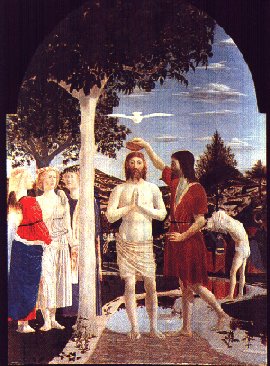
Matthew is the only Gospel writer to describe the Nativity, leading one to suspect that its derivation lies in the recreation of the 'divine child' mythology. Gilbert points out the connection with John:
"So important was the legend of the Magi considered to be by the Church that the Epiphany, celebrated in honour of their supposed visit, is a major feast day. However, the 6th January was not always connected with Jesus' physical birth. In the early Church, it was indeed a Holy Day but it had nothing to do with the nativity. Rather it was considered to be the day of Christ's Baptism in the Jordan River and was called the 'Day of Lights', relating to the Illumination of Jesus and the Light which shone in the Jordan." (7)
Gilbert does not bring this point to our attention to create doubt in our minds that the Nativity was a later construction of the Roman Church. But that is surely the effect. The early Christian church described the baptism of Christ by John as the 'Day of Lights', and later incorporated the myth of the Magi's visit into this crucial date. Instead, the first appearance of the Divine Star occurred with the symbolic baptism of Jesus by John, initiating the Christ figure into the Isian rites associated with the Messianic Star.
Only later, when the connection of Christianity with pagan polytheism needed to be exorcised, did the Church replace this initiating event with the Nativity.
This date of 6th January might symbolise the first time that the emergent divine star was seen by the astronomers and astrologers of 25 AD, as it progresses from Cancer to Sirius, to be 're-born' in the sky. This penultimate section of the Duat became the 'Day of Lights' in early Christian mythology. The Baptism symbolism is understood in this context through the Biblical recollection of the Flood. After all, this was caused by a Nibiruan passage 10,000 years in the past, disaster which 'cleansed the Earth' and brought about the destruction of the Annunaki's extensive operation on this planet.
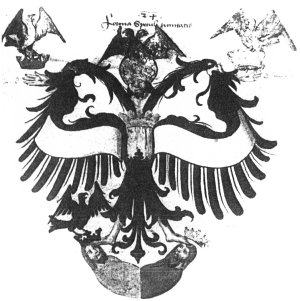
It is not hard to see why the Egyptian ritual of Baptism would suddenly become highly fashionable in Judea as the Messianic Star reappeared. By cleansing one's sins through full immersion in water, the people of that time recalled the past destruction the brown dwarf brought about, atone for their own sins, as well as hope that the same was not about to happen again. Fear of this world-wide cataclysm lead the people of the Middle East into the arms of the Baptist. His was the original Messianic Movement of 1st Century Judea.
So the date 25 AD indicates the beginning of the Christian movement itself, possibly some time before the actual crucifixion. But the symbolic timing of the crucifixion was the same as the Nibiruan appearance, in the Spring, to mark the death and rebirth of the Messianic Star. At this point, Nibiru dipped below the horizon, and its movement through the realm of the 'god of the dead', Osiris, was lost to viewers on Earth. I will leave it to others to verify the veracity of the Christian account. It may have happened historically, or it might be mythology built upon the Dark Star astronomy, like so much other ancient myth.
Likewise, the actual identity of Christ is beyond the scope of this web site. My interest lies with the tie-in between the scientific basis for Nibiru and its mythology, and my stance on Christianity as a religion is neutral. It is not the purpose of this essay to question the divinity of Jesus Christ, but rather to place his story in the context of a wider mythology.
Mithras
Finally, a point about the apparent lack of reaction in the Roman Empire to the appearance of the Messianic Star. This is a problem particularly for Biblical scholars trying to pinpoint the historical appearance of this celestial object. As far as I know, this is one of the few times that the Star of Bethlehem has been explained by the actual appearance of an new star. Most other theories call for conjunctions of the planets, meteors, super novae or even UFOs. What is plain to all is that the Early Christians placed a great deal of importance on the vision of the Star, yet its appearance in contemporary records of that time was notable by its absence.
This proposed solution addresses this issue in a radical new way, pointing out the cultural difference between the dominant Romans and the subjugated people of Israel and Egypt. The Romans, like the Greeks, were completely ignorant of the Winged Planet, being a European culture, much younger than the ancient Mesopotamian and Egyptian civilisations. As an astronomical event, it was difficult to spot because of the time of year it appeared, and Seneca erroneously noted its appearance as Sirius itself.
There is another possibility, however, that could provide evidence that the Romans and Greeks also worshipped this new star. The 1st and 2nd Centuries AD saw the blossoming of a cult with marked similarities to Christianity, that of the god Mithras. Originally an alternative version of Zoroastrianism, Mithras was a fiery Sun-god with heroic qualities. Gilbert describes what is known of the Roman version of this ancient Persian god:
“Unfortunately, little in the way of writings concerning Roman Mithraism have come down to us although there are a number of reliefs and statues still in existence that give us the broad outlines of what the cult was about. Its central legend has clear links with both Zoroastrian and Biblical creation myths. Mithras, like Gayomart, is a divine child.” (7)
Here we have a cult, which originated in Persia, suddenly taking hold in the Roman Empire around the same time as the emergence of the early Christian church. Its focus was a fiery sun-god who was a divine child, born on 25th December, not dissimilar to the Egyptian messianic symbolism. It seems likely that Mithras became the Roman cult of Nibiru, based upon appearance of the fiery star noted by Seneca. The main aspect of the Mithras myth holds further clues. This god was famous for his sacrifice of the heavenly bull. He seized the bull by the horns, and was then dragged until ‘the great beast collapsed’.
He then picked it up by its hind quarters and pulled it back to his cave , where he sacrificed it. If the heavenly bull is Taurus, and I am correct in identifying Mithras as the Winged Planet moving through the last stage of its visible perihelion, then this could allude to the retrograde motion of the divine star through the constellation: Firstly moving directly onto the horns of the bull, then dragged by them, then grabbing the flank before disappearing into the darkness of the 'cave' for the sacrificial rite. This would imply that the increasingly dim countenance of Nibiru was followed by the Romans before it disappeared from Taurus into the primordial deep. The Mithras mythology was invoked in cult-form following this celestial passage.

The Egyptians were more prepared for Nibiru's appearance, through its ancient stellar religion, and I suggest that a new, highly significant cult arose directly because of its perihelion passage.The writings of the Alexandrian philosopher Philo (30BC – 45 AD) would seem to bear this out. The Egyptian city of Alexander was one of the predominantly intellectual centres of the 1st Century world. Early Christianity thrived here, and this Jewish citizen wrote contemporary passages which seemed to allude to the connection between the Celestial and Human Messiah. Gilbert describes his findings regarding Philo:
“One of these great symbols, as far as Philo is concerned, is the doctrine of the Logos as the Son of God. He writes: Moreover God, as Shepherd and King, leads [and rules] with the law and justice the nature of the heaven, the periods of sun and moon, the changes and progressions of the other stars – deputing [for the task] His own right Reason (Logos), His First-born Son, to take charge of the sacred flock, as though he were the Great King’s viceroy.
"Mead, in his commentary on this passage discusses how this ‘Heavenly Man’ was for Philo the Celestial Messiah of God. He goes on to quote… Moreover, I have heard one of the companions of Moses uttering such word [logos] as this: ‘Behold Man whose name is East’...” (6)
This research of Gilbert seems to confirm that the origin of the Messiah is indeed celestial, at least in the eyes of the Egyptians. Combine this with the sudden phenomenon of the cult of Mithras in the Roman world, and the Messianic Star tradition in Christianity and a common thread is developing throughout the civilised world of that time. It was a reaction to some event, and I propose that it was the partially observed perihelion passage of Nibiru, the Dark Star.
Conclusion
This paper offers us the possibility of synthesising Sitchin's 12th Planet Theory with early Christianity, using raw astronomical data as evidence. Seneca's essay on fiery celestial phenomena in 25 AD included an undeniable reference to a 'piercing' red star in Canis Major, and this event may indeed have triggered the writing of his document. Because he regards the star as Sirius, it has been included in the dubious sack of astronomical 'old chestnuts', the red 'Sirius' anomaly. Yet it stands alone as an irrefutable piece of evidence of a truly anomalous event.

When one takes the unusual step of regarding Seneca's sighting as that of an actual red 'star' appearing near Sirius, and effectively outshining it, then the myth of the Star of Bethlehem begins to find a home in historical reality. The reason why this thought has not been considered before is that astronomers simply would not consider it possible that another planet could move into the Solar System in this way. But for those familiar with Sitchin's work, and the arguments I have put forward in the Dark Star Theory, regarding the new astronomical evidence for Nibiru's identity as a brown dwarf, this ancient scientific evidence offers the possibility of pin-pointing Nibiru's last passage, and realising its effect on the civilised world at that time.
Many of the mysteries of the events of 1st century Palestine can be readily understood in this context, as well as repercussions felt elsewhere in the Roman Empire. This hypothesis also allows us to extrapolate into the future, to a point when Nibiru will appear again.
Unfortunately, the repercussions of this next passage are more ominous.
Continue to DarkStar9
Written by
Andy
Lloyd,
21st August 2000
author of 'The Dark Star'
(2005), 'Ezekiel One'
(2009), 'The Followers of
Horus' (2010) and 'Darker Stars' (2019) Published by Timeless Voyager Press
References
1) D.C.B. Whittet "A Physical Interpretation of the ‘red Sirius’ Anomaly" Mon. Not. R. Astron. Soc., 310, 335-359 (1999)
academic.oup.com/mnras article
2) D.C.B. Whittet "Colour Change of Sirius" Journ. Brit. Astron. Assoc., 87, 523 (1977)
3) R. Ceragioli "The Debate Concerning ‘Red’ Sirius" J. Hist. Astron., 26, 187
4) R. Ceregioli "Solving the Puzzle of ‘Red’ Sirius" J. Hist. Astron., 27, 93
5) Robert Bauval & Graham Hancock "Keeper of Genesis: A Quest for the Hidden Legacy of Mankind" p183, Mandarin 1996
6) Lynn Pickett and Clive Prince "The Templar Revelation: Secret Guardians of the True Identity of Christ " p46 Bantam Press 1997
7) Adrian Gilbert "Magi: the quest for a secret tradition " pp20, 52-56, 63 Bloomsbury 1996